Scientist proposed cloud engineering as response to global warming

A controversial idea about shooting salt water high into the sky over the oceans to create clouds that reflect sunlight, is now reconsidered again in order to battle global warming. Rob Wood, physicist at University of Washington, proposes an experiment to test the concept on a small-scale. A comprehensive paper was published this month in the journal Philosophical Transactions of the Royal Society. Wood urges scientists to consider the idea of marine cloud brightening. Marine cloud brightening is part of a broader concept known as geoengineering which encompasses efforts to use technology to manipulate the environment. 25 other scientists have endorsed the idea. However, despite increasing interest from scientists like Wood, there is still strong resistance to cloud brightening.
The theory behind so-called marine cloud brightening is that adding particles of sea salt to the sky over the ocean would form large, long-lived clouds which could reflect light back into universe. Seeding marine stratocumulus clouds with copious amounts of tiny sea water particles could theoretically significantly enhance cloud droplet number concentration, and thereby cloud reflectivity and longevity. Since there is a limited amount of water in the air, adding more particles creates more, but smaller, droplets. A greater number of smaller drops has a greater surface area, so it means the clouds reflect a greater amount of light back into space, creating a cooling effect on Earth.
The amount of sunlight reflected also depends on several factors, including the distribution of injected aerosols, ambient levels of water vapor and pollution, and the timing of aerosol injections (because cloud brightening is only meaningful in the daytime). PNNL-NOAA study team found that adding aerosols changes the amount of rain falling from clouds, which is an important result because changes in rainfall and other climate variables may have even larger impacts than changes in temperature alone.
The idea behind the marine cloud brightening (MCB) geoengineering technique is that seeding marine stratocumulus clouds with copious quantities of roughly monodisperse sub-micrometre seawater particles could significantly enhance the cloud droplet number concentration thus increasing the cloud albedo and longevity – thereby producing a cooling, which computations suggest could be adequate to balance the warming associated with a doubling of atmospheric carbon dioxide.

Climate model simulations suggest that if the droplet concentration in marine stratocumulus can be increased to several hundred droplets per cm3 in a significant fraction of the stratocumulus sheets, then, in principle, a negative forcing can be produced, sufficient to offset doubled CO2 and maintain the polar sea-ice coverage at roughly current values. If this was achieved, the global distributions of surface temperature and sea-ice cover would inevitably be different from the present situation. Some of the potential unintended consequences are shifting weather patterns or effects on Arctic sea ice.
Wood and his research team proposed trying a small-scale experiment to test the feasibility and begin to study effects. The test should start by deploying sprayers on a ship or barge to ensure that they can inject enough particles of the targeted size to the appropriate elevation. An airplane equipped with sensors would study the physical and chemical characteristics of the particles and how they disperse. By using additional airplanes to study how the cloud develops and how long it remains. The final phase of the experiment would send out five to 10 ships spread out across a 100-kilometer stretch. The resulting clouds would be large enough so that scientists could use satellites to examine them and their ability to reflect light.
Located in the boundary layer, the lowest level of the earth's atmosphere, marine stratocumulus clouds cover vast areas of the ocean surface. When aerosol particles from ship exhaust enter these clouds, tell-tale "ship tracks" are visible in satellite images.
There are 25 authors on the paper, including scientists from the University of Leeds, University of Edinburgh and the Pacific Northwest National Laboratory. The lead author is John Latham of the National Center for Atmospheric Research and the University of Manchester, who pioneered the idea of marine cloud brightening.
Read the entire paper
Back in 20120, Bill Gates announced plans to invest $300,000 into research at the University of Calgary which propose lab tests on machines that suck up seawater and spray it into the air, seeding white clouds that reflect rays of sunlight away from Earth. San Francisco-based research group Silver Lining, developed the machines which can suck up ten tons of water per second and turn seawater into tiny particles that can be shot up over 3,000 feet in the air, increasing the density of clouds by increasing the amount of nuclei contained within. The Silver Lining Project is a not-for-profit international scientific research collaboration to study the effects of particles (aerosols) on clouds and the influence of these cloud effects on climate systems.
Sources: RSTA, Univerity of Washington, phys.org

Living here in Astoria, Oregon, I’ve been expecting articles such as this one for some time and I’ve seen several. We’ve seen a massive geoengineering project in the northwest, and it’s getting more and more obvious to more and more people. I even discovered on the internet that one of the main arms of the cloud seeding is right here in Oregon: Evergreen Air in Hillsboro.
Of course, it’s not just in the US: i was shocked to see the Paris sky “plein” last November. All i have to say is, Hey, give me back my dewpoint! Science is not making our lives better. We have reached the tipping point, Bill Gates be damned!
Moineau,
Just south of you in C.B.
¡Salud!
saludo, GK! xoxoox
They are merely seeking approval, or staging the process of getting approval from the public to do what they are already doing in secret. These nut cases are not human but sub-human.
Honestly, I wish I was a monkey. Being human is just too embarrassing.
Why not prevent further change by dramatically reducing the use of fossil fuels. Oh, right… Economy beats ecology. And if you suggest otherwise, you are a tree hugger or terrorist.
What effects will salt rain have on crops and natural vegetation?
@Gramslam,
“Honestly, I wish I was a monkey. Being human is just too embarrassing.”
Comedic gold right there. Also potential sig line for the opportunist.
i THINK IT IS TIME THE BILL GATES OF THIS WORLD STOOD DOWN IF NOT IT WONT BE LONG BEFORE WE ALLFALL VICTIMS TO ONGOING EXPERIMENTS BY THESETYPE OF PEOPLE TO FINE TUNE NATUREAND THE PEOPLE WHO INHABIT THIS EARTH.
The article had a lot of “should’ve, would’ve and could’ve” for a topic that’s highly debatable as aerosols continue to create more problems for Earth’s atmosphere.
Now the scientific community (and their pet projects) wants to inject more particles in to our atmosphere to see ‘if’ that will cool the Earth’s atmosphere through a model that was generated in a lab therefore altering climate?
Really? You’re joking, right?
What are we lab rats?
At least being a lab rat is in a controlled environment. Who knows (because of speculation) what the end result will be with Marine Cloud Brightening . . . by the way, sounds like a bad name for toothpaste.
The article quotes Bill Gates as one of the contributors @ 300K. Newsflash, he’s his own worst enemy and ours. Thanks for all the wonderful products you’ve created for us over the years Bill, but stick to what you know best.
I don’t need people that bloviate in their ivory towers with language from higher learning that requires an interpreter and Merriam Webster to explain what is best for me and or others that share the same sentiment.
Where’s the threshold coupled with checks and balances?
Hey geniuses, here’s an idea, stop altering and or geoengineering the global climate unnaturally for the sake of the people on planet Earth so you can write about the topic in a scientific journal for future (more like a footnote) reference allowing your colleagues to acquire more private funding or grant money and that’s ‘if’ the project goes well.
We all know that you want to pat each other on the back for a job well done (who doesn’t) at your annual forums and business meetings, but at what expense?
As it stands:
Massive crop failures.
Aerosols are problematic to our atmosphere.
The arctic and regular jet streams are out of sync.
Unprecedented global flooding in parts of the world.
More cloud coverage = cooling, okay, I’ll give you that brief moment of clarity, but what about warming the atmosphere with your project?
By all means I am no greenie, but ladies and gentlemen . . . common sense, observation and the ability to check yourself left the building decades ago.
Stupid as stupid does. How much jet fuel will be used and how much pollution they will be putting into the air at the same time they spray?
And what could POSSIBLY go wrong? Reducing the amount of light getting to the seawater is NOT a good idea. Where do you think the lion’s share of oxygen comes from? NOT the trees.